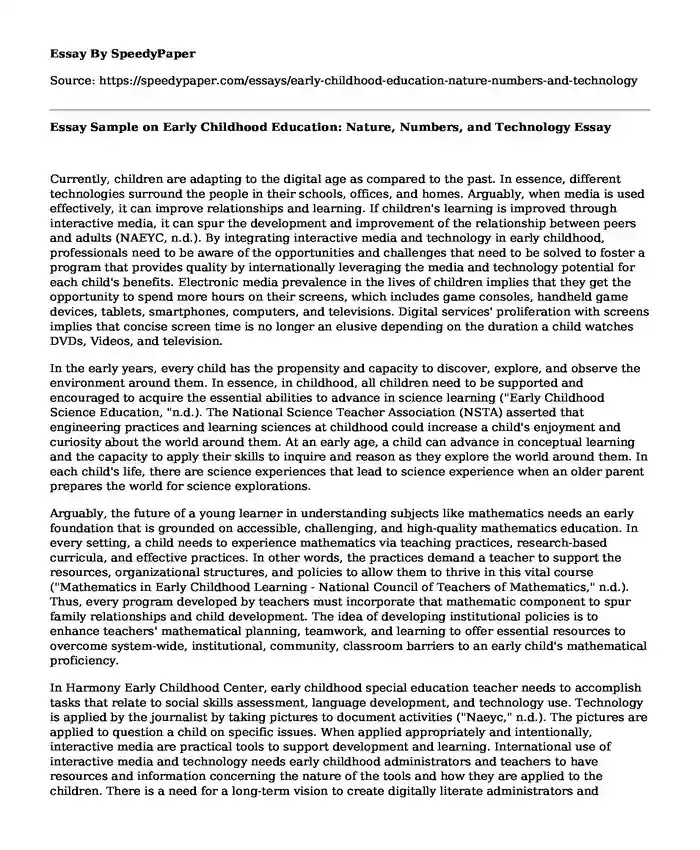
| Type of paper: | Essay |
| Categories: | Learning Mathematics Child development Childhood Human development |
| Pages: | 3 |
| Wordcount: | 609 words |
Currently, children are adapting to the digital age as compared to the past. In essence, different technologies surround the people in their schools, offices, and homes. Arguably, when media is used effectively, it can improve relationships and learning. If children's learning is improved through interactive media, it can spur the development and improvement of the relationship between peers and adults (NAEYC, n.d.). By integrating interactive media and technology in early childhood, professionals need to be aware of the opportunities and challenges that need to be solved to foster a program that provides quality by internationally leveraging the media and technology potential for each child's benefits. Electronic media prevalence in the lives of children implies that they get the opportunity to spend more hours on their screens, which includes game consoles, handheld game devices, tablets, smartphones, computers, and televisions. Digital services' proliferation with screens implies that concise screen time is no longer an elusive depending on the duration a child watches DVDs, Videos, and television.
In the early years, every child has the propensity and capacity to discover, explore, and observe the environment around them. In essence, in childhood, all children need to be supported and encouraged to acquire the essential abilities to advance in science learning ("Early Childhood Science Education, "n.d.). The National Science Teacher Association (NSTA) asserted that engineering practices and learning sciences at childhood could increase a child's enjoyment and curiosity about the world around them. At an early age, a child can advance in conceptual learning and the capacity to apply their skills to inquire and reason as they explore the world around them. In each child's life, there are science experiences that lead to science experience when an older parent prepares the world for science explorations.
Arguably, the future of a young learner in understanding subjects like mathematics needs an early foundation that is grounded on accessible, challenging, and high-quality mathematics education. In every setting, a child needs to experience mathematics via teaching practices, research-based curricula, and effective practices. In other words, the practices demand a teacher to support the resources, organizational structures, and policies to allow them to thrive in this vital course ("Mathematics in Early Childhood Learning - National Council of Teachers of Mathematics," n.d.). Thus, every program developed by teachers must incorporate that mathematic component to spur family relationships and child development. The idea of developing institutional policies is to enhance teachers' mathematical planning, teamwork, and learning to offer essential resources to overcome system-wide, institutional, community, classroom barriers to an early child's mathematical proficiency.
In Harmony Early Childhood Center, early childhood special education teacher needs to accomplish tasks that relate to social skills assessment, language development, and technology use. Technology is applied by the journalist by taking pictures to document activities ("Naeyc," n.d.). The pictures are applied to question a child on specific issues. When applied appropriately and intentionally, interactive media are practical tools to support development and learning. International use of interactive media and technology needs early childhood administrators and teachers to have resources and information concerning the nature of the tools and how they are applied to the children. There is a need for a long-term vision to create digitally literate administrators and teachers who have experience, skills, and knowledge to use and select interactive media and technology tools that suit generation and children's developmental levels in their care. Also, there is a need to know when and how technology can be integrated to facilitate a smooth program.
References
Early Childhood Science Education. (n.d.). Homepage | NSTA. https://www.nsta.org/nstas-official-positions/early-childhood-science-education
Mathematics in Early Childhood Learning - National Council of Teachers of Mathematics. (n.d.). Index - National Council of Teachers of Mathematics. https://www.nctm.org/Standards-and-Positions/Position-Statements/Mathematics-in-Early-Childhood-Learning/Naeyc. (n.d.).
NAEYC. https://www.naeyc.org/resources/pubs/yc/sep2017/technology-and-interactive-media(n.d.).
NAEYC. https://www.naeyc.org/sites/default/files/globally-shared/downloads/PDFs/resources/topics/PS_technology_WEB.pdf
Cite this page
Essay Sample on Early Childhood Education: Nature, Numbers, and Technology. (2023, Aug 24). Retrieved from https://speedypaper.com/essays/early-childhood-education-nature-numbers-and-technology
Request Removal
If you are the original author of this essay and no longer wish to have it published on the SpeedyPaper website, please click below to request its removal:
- Literacy Narrative Essay Example
- Social Learning about Predators. Free Essay Example.
- Free Essay Sample: Optimization of Satellite Communication
- Free Essay Describing Elements of Creativity in the Business World
- Free Paper on the Importance of a Primary School Website
- Essay Sample on Protein Synthesis: DNA Replication, Transcription, Translation for Cell Function
- Essay Sample on Fredrick Douglass and Hamlet Comparison Essay
Popular categories




